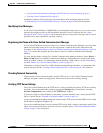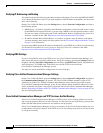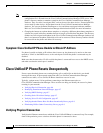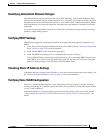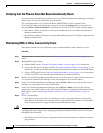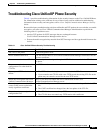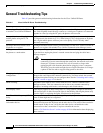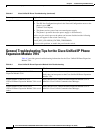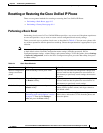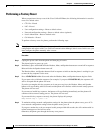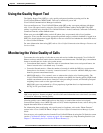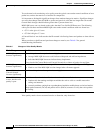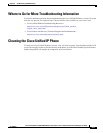
8-11
Cisco Unified IP Phone 7960G/7940G Administration Guide for Cisco Unified Communications Manager 7.0 (SCCP)
OL-15498-01
Chapter 8 Troubleshooting and Maintenance
General Troubleshooting Tips
Sound sample mismatch between the
phone and another device.
The RxSize and the TxSize statistics show the size of the voice packets that are being
used in a conversation between this IP phone and the other device. The values of these
statistics should match.
See the “Call Statistics Screen” section on page 6-10 for information about displaying
these statistics.
Gaps in voice calls. Check the AvgJtr and the MaxJtr statistics. A large variance between these statistics
might indicate a problem with jitter on the network or periodic high rates of network
activity.
See the “Call Statistics Screen” section on page 6-10 for information about displaying
these statistics.
Checking signaling. To check that signaling is working properly between the phone and Cisco
Unified
Communications Manager, press the Speaker button on the phone to answer
a call. If you can answer a call and if you hear a dial tone, signaling is working
properly.
Checking the handset cradle clip. Cisco Unified IP Phones are designed with a reversible handset clip in the cradle. This
clip is used with the plastic tab protruding out when the phone is in a vertical
(wall-mounted) position. The position of the tab can interfere with the handset as it is
placed in the cradle. If the phone remains in the on-hook position you may experience
continued ringing when you try to answer a call or a lack of dial tone when you try to
place a call. To resolve this problem, you may need to reverse the clip.
If the handset cradle clip is in the wall-mounted position and your phone is placed on
a desktop, slide the clip upward to remove it. Rotate the clip 180 degrees and slide it
back in so that the tab is hidden.
If the hook switch remains in the down position, tapping on the phone should free up
the switch. You can also try pushing and suddenly releasing the off-hook button after
the handset has been picked up.
Checking the hook switch contacts. The hook switch contacts on the phone use a wiping action to self-clean the contacts.
If your phone is not used regularly, dust and other airborne contaminants may degrade
the contact performance and cause problems with operation. If you have periods of
limited phone usage, you can clean the contacts by quickly pressing and releasing the
hook switch a dozen times.
Checking the position of the phone. The footstand of the phone allows adjustment of the phone to eliminate glare on the
LCD screen. When the phone is in the most vertical position, the phone may be forced
forward and the handset may not sit properly in the cradle, creating a false off-hook
condition. Cisco recommends that you position the phone one notch from the most
vertical position to ensure that the handset is firmly resting on the hook switch.
Checking the LAN cable. Make sure that the LAN cable connected to the phone is positioned properly. The LAN
cable should pass out of the side of the phone between the base and the footstand. If
you are using a cable (such as Cat-5E or Cat-6) with a larger diameter than the cable
that was packaged with your phone, the cable may cause the phone to tilt forward and
force it off-hook. Use a smaller LAN cable to eliminate this problem.
Table 8-2 Cisco Unified IP Phone Troubleshooting (continued)
Summary Explanation



